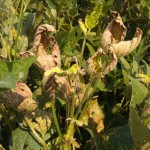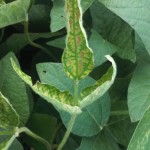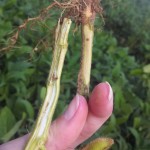There have been multiple reports of Sudden Death Syndrome (SDS) in soybean fields in Tennessee. The cool, wet season Tennessee has experienced has helped promote the disease in susceptible varieties.
SDS is caused by the soilborne fungus Fusarium solani f. sp. glycines which produces a toxin that is translocated to the foliage resulting in the scattered, interveinal chlorotic spots in leaves (see images below). These spots may become necrotic or enlarge to form chlorotic streaks that become necrotic. Affected leaflets will detach from the petioles, leaving just the petioles attached to the plant. SDS leaf symptoms can look similar to southern stem canker, brown stem rot, and pesticide (triazole fungicides) burn. By examining the entire plant one can correctly identify SDS –after splitting the stem, the middle pith should be white, while the vascular tissue surrounding the pith will be discolored (image below), and there should not be any fungal development or cankers on the outside of the stem. If only foliage that had contact with a pesticide displays symptoms and new growth is unaffected, a pesticide burn is most likely the cause and not a disease. Descriptions and pictures of disease symptoms and management option on soybean diseases can be found at UTcrops.com (Soybean Disease and Nematode Identification Guide).
SDS is usually more severe in saturated soils, such as in low spots and in irrigated as opposed to non-irrigated fields. Fields that develop SDS are likely to develop the disease during subsequent years when favorable weather conditions occur. Management options include planting a resistant to moderately resistant variety, using cultivation practices that prevent or reduce soil compaction and improve drainage in low spots, and reducing soybean cyst nematode populations.





